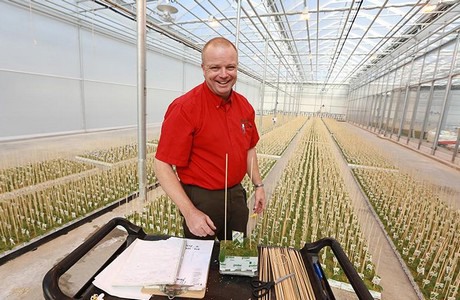
"We knew this was coming, but when you see it on your bill then it is actual pain and real dollars", said industry heavyweight Jan VanderHout. Wearing the hats of Chairman of the Ontario Fruit and Vegetables Growers' Association, President at the Ontario Greenhouse Alliance and board member of the Ontario Greenhouse Vegetable Growers, VanderHout is worried about the future of his industry under the new Cap and Trade program.
"The intention of the Cap and Trade program is to reduce the use of fossil fuels and initiate carbon neutral heat sources like solar, wind and geothermal energy. In some jurisdictions this is no problem, but in Ontario it will be very difficult for greenhouse growers to implement this, especially in the short term."
In addition, Ontario growers are also competing with trucked in produce from B.C. and Alberta. In these provinces, greenhouse growers have received significant rebates within a similar mandatory Carbon Tax program.
"The Cap and Trade would have been no problem for us if we could get that money back out of the marketplace. But that only works when everybody can produce at the same level. Competing imports from the U.S. and Mexico similarly, do not have the burden of Carbon pricing at this time.”
VanderHout, owner of Beverly Greenhouses, explained that he and his colleagues already have to deal with heavy heating costs in the winter months. He is doing his utmost to pull his locally grown cucumber crops through the cold and dark months with the lowest possible energy input. Within the new cap and trade program however, growers have seen their energy bill increase by 15 to 20%. "It is hidden in the delivery charges of the natural gas, these have seen an increase of 115% for most of us."
Just like many of his peers, VanderHout has taken several measures to run his greenhouse operation as efficiently as possible, with the smallest environmental footprint possible. But the fact that growers already have taken energy conserving measures does not matter anymore.
In fact, VanderHout explained that some growers would be better off without curtains or a condensing boiler. "Greenhouses that emit more than 10,000 tons can opt in and manage their own trading of carbon credits. This system gives them free allowances. That is just the way it is modeled, it's not fair."
But by nature, leaving their screens and vents open in order to burn more natural gas or oil and emit more to become eligible to opt in to the program is not the way to go for the smaller growers.
"This would be backwards thinking of course. We are on the same page as the government in that we need to take drastic measures to tackle climate change. We do support being environmentally responsible, and cap and trade is not an unrealistic program, but under the current terms and conditions it does not keep us alive."
Therefore, VanderHout and the organizations he represents are in ongoing discussion with the government. "They also know that this is hurting us and say they are struggling to come up with a solution. It will be a challenge to come up with a solution other than just relieving our taxes. We need a compensation that recognizes our ongoing intention to reduce our energy usage."
Aggregation or creating a co-op or a collective of growers to consolidate their carbon output is not an option for the smaller growers. "We asked if this was possible, but they will not allow us to, as the cap and trade applies to every single meter. They cannot gives us any rebates or an exemption either. We need to look for some other kind of solution to offset the costs."
VanderHout says that he and his organizations will continue to work hard to find a solution and inform the provincial government about the importance of the agricultural producers. "We tell them that we need to be viewed differently than other industries in this respect. We are not making iPhones, but produce basic necessities of life."
The Ontario Fruit and Vegetable Growers’ Association (OFVGA) is the umbrella organization for the province’s fruit and vegetable farmers representing 27 different grower groups. Click here for their complete comment on the Ontario Cap and Trade Program.
